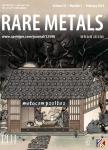A comparison of core–shell Si/C and embedded structure Si/C composites as negative materials for lithium-ion batteries
A comparison of core–shell Si/C and embedded structure Si/C composites as negative materials for lithium-ion batteries作者机构:Grinm Group Co.Ltd.Beijing 100088China General Research Institute for Nonferrous MetalsBeijing 100088China China Automotive Battery Research Institute Co.Ltd.Beijing 101407China
出 版 物:《Rare Metals》 (稀有金属(英文版))
年 卷 期:2021年第40卷第9期
页 面:2440-2446页
核心收录:
学科分类:0808[工学-电气工程] 08[工学] 0805[工学-材料科学与工程(可授工学、理学学位)] 080502[工学-材料学]
基 金:financially supported by the National Key R&D Program of China(No.2016YFB0100400) the National Natural Science Foundation of China(Nos.51504032,51604032 and U1664256)
主 题:Lithium-ion battery Negative materials Silicon-based materials Material structure
摘 要:Silicon materials have attracted wide attention as negative materials due to exceptional gravimetric capacity and abundance. The strategy of using nano-silicon materials as structural units to construct nano/micro-structured silicon-based negative materials for lithium-ion batteries has come into sight in recent years. In order to provide guidance for the material structure design of micro-sized silicon-based negative materials in practical application, in this work, two commercialized nano/micro-structured silicon-based negative materials with a specific capacity of about 650 mAh·g^(-1) were investigated and compared in the aspects of material microstructure, electrochemical performance of half cells, and electrode morphological evolution during cycling. The cycling performance(with capacity retention ratio of about 17% higher after 100 cycles) and electrode structure maintenance of the embedded structure Si/C material are superior to those of core–shell Si/C material. This research can provide guidance on design and application of nano/micro-structured silicon-based negative materials.



